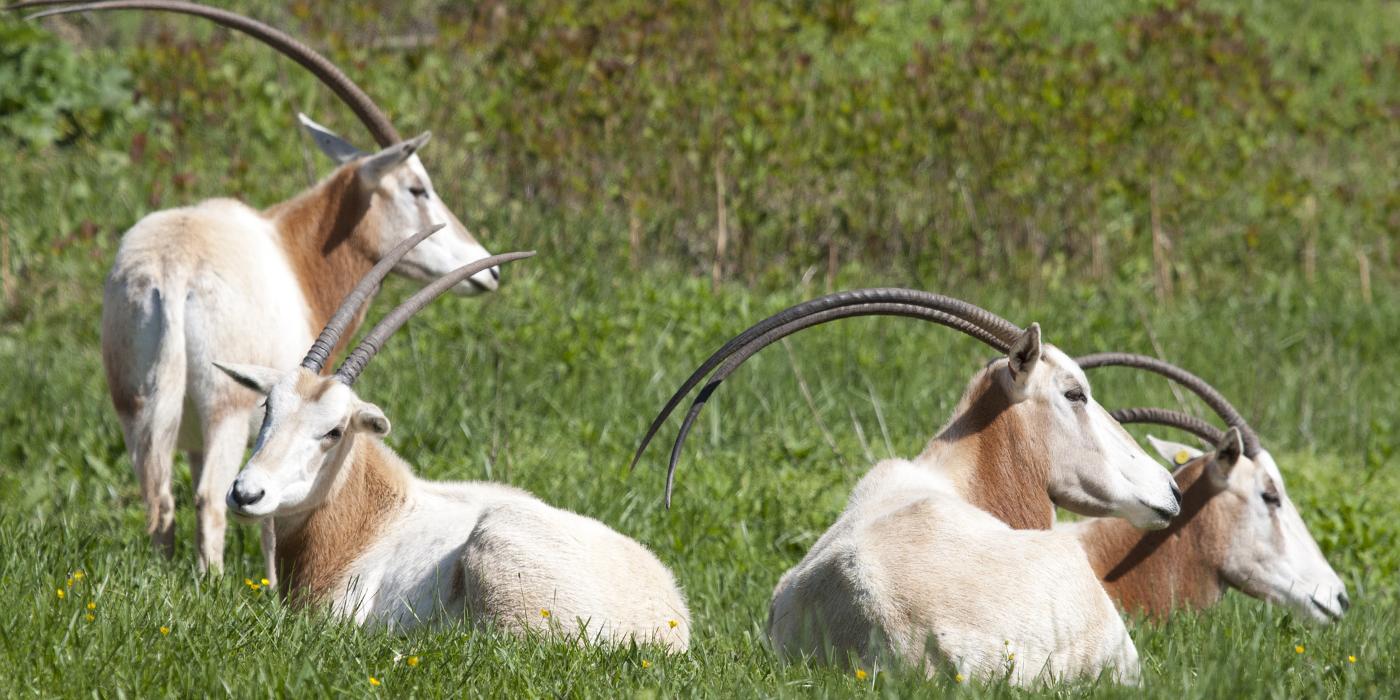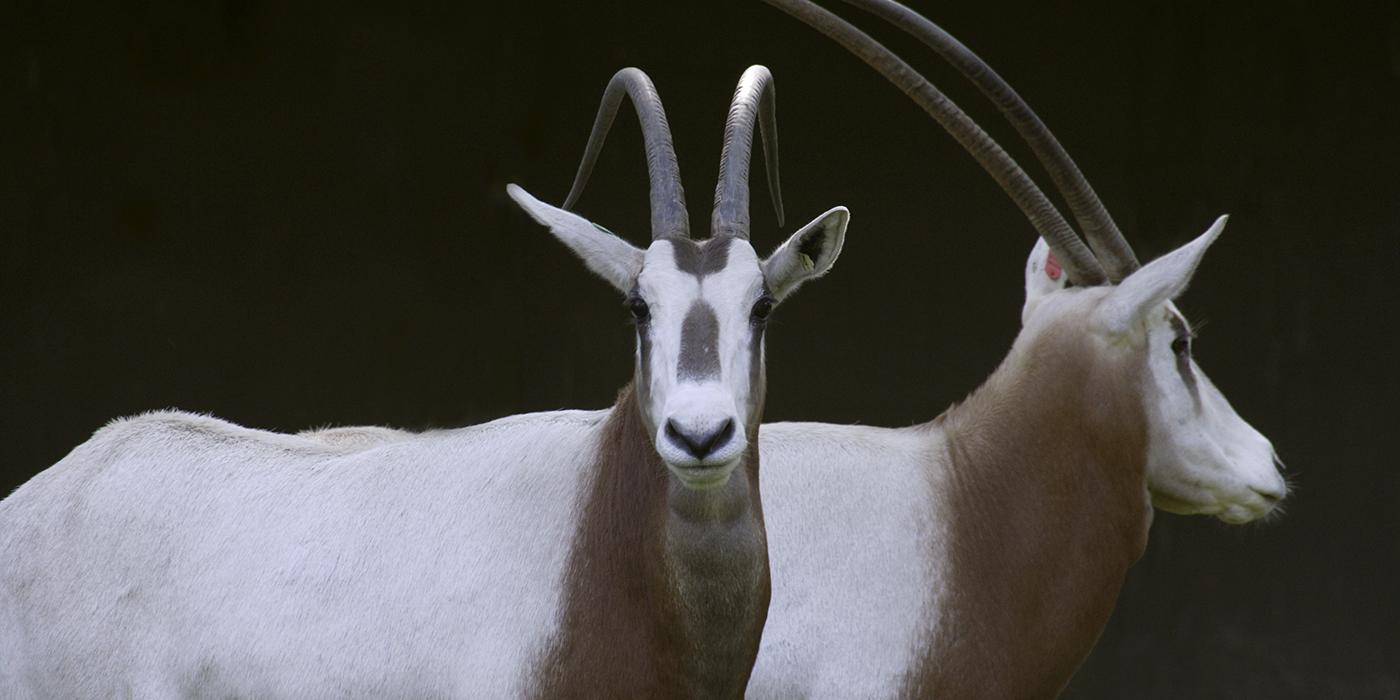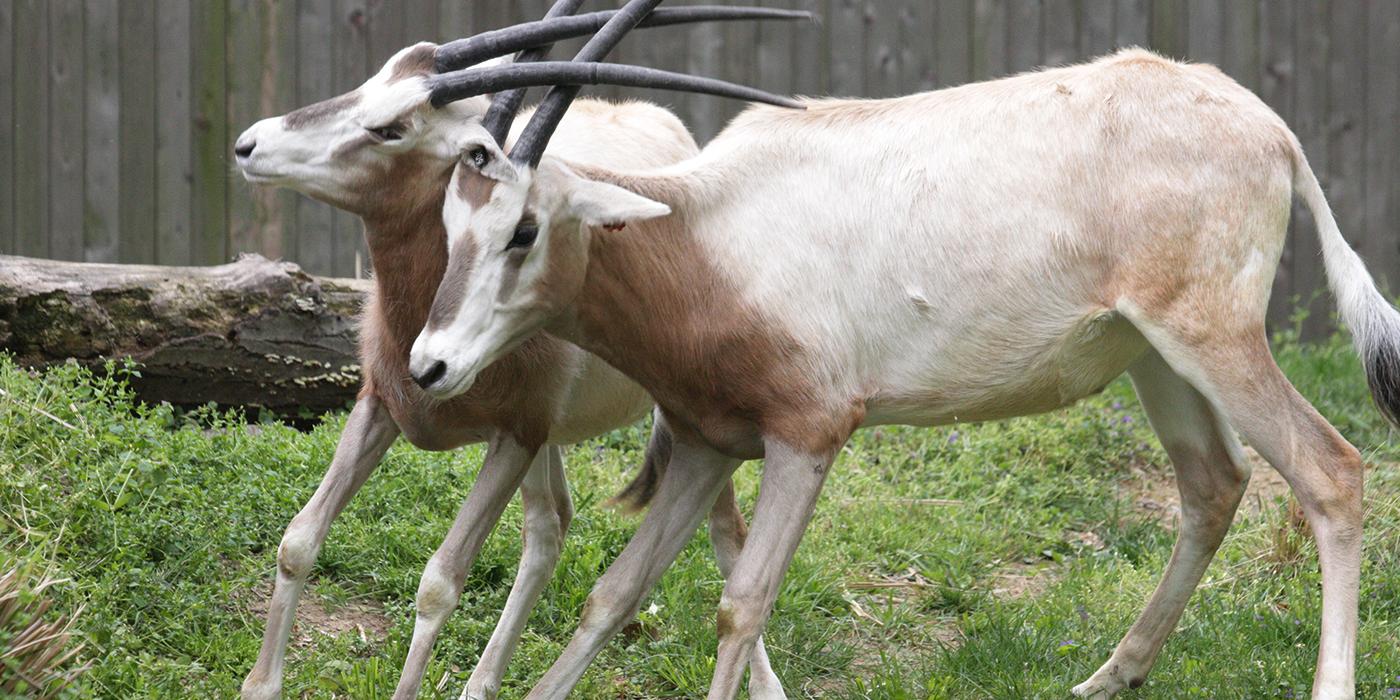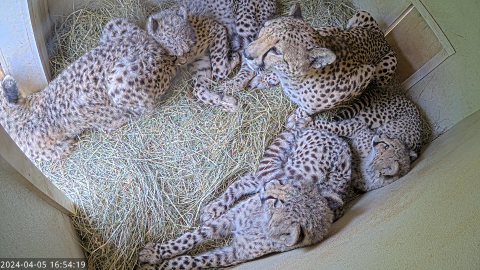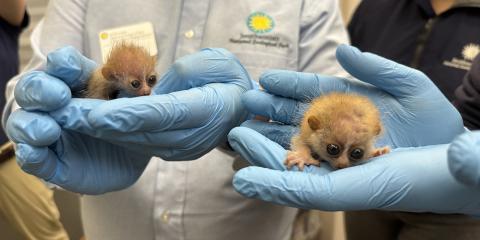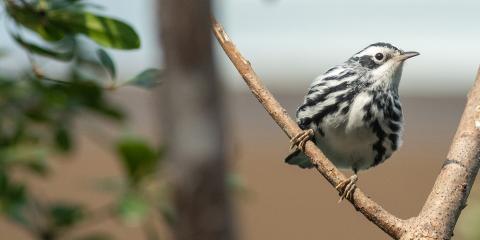Physical Description
Oryx are mostly white with reddish brown necks and marks on the face and a long, dark, tufted tail. The white coat helps reflect the heat of the desert. Their black skin and tip of the tongue protects against sunburn while enlarged hooves enable the oryx to walk easily on sand. Dense eyelashes and strong eyelids protect against windblown sand.
Both male and female scimitar-horned oryx have long, ridged, sharp-tipped and curved backwards horns that grow to be several feet long.
Scimitar-horned oryx have an interesting way of coping with a shortage of water. They are able to tolerate a rise in body temperature by several degrees. Being able to tolerate an internal body temperature of 116 degrees Fahrenheit means oryx do not need to sweat as much, which in turn conserves water. This adaptive hyperthermia allows them to rid themselves of excess heat at night when their body temperatures can drop below normal.
In addition to this physiological adaptation to hot and arid environments, they can go for long periods without drinking water. They dissipate heat through their appendages.
Size
These desert antelope stand up to 4.6 feet (1.4 meters) tall at the shoulder, and their head and body length is between 4.9 to 7.5 feet (1.5 and 2.3 meters). They weigh between 220 to 460 pounds (100 and 210 kilograms).
Native Habitat
A century ago, hundreds of thousands of desert-adapted antelopes roamed the Sahara and Sahel regions of Northern Africa, a vast desert and sub-desert ecosystem that include parts of Morocco, Tunisia, Algeria, Libya, Egypt, Mauritania, Mali, Niger, Chad and Sudan.
Due to human disturbance, over-hunting, drought and loss of food because of excessive livestock grazing, the scimitar-horned oryx is now extinct in the wild, though surveys show that Niger and Chad may have appropriate habitat for reintroduction, and some reintroductions have begun in Tunisia.
Lifespan
The life span of oryx in the wild is unknown, but in human care it is possible for them to live into their twenties.
Food/Eating Habits
Arid-land antelope, unlike livestock, are well suited for their habitat, surviving for months and even years without drinking water, stripping moisture from the plants they eat in their sparsely vegetated habitats. Scimitar-horned oryx migrate enormous distances searching for fresh grazing and water. They can detect slight variation in air humidity over long distances.
Scimitar-horned oryx eat grasses, herbs, juicy roots, and buds. Acacia seedpods provide important nutrients for mothers with young calves. Wild melon and the twigs and shoots of Capparis are vital sources of moisture. Feeding at night allows oryx to take advantage of higher water content in their forage. They produce very dry fecal pellets and highly concentrated urine.
The Smithsonian's National Zoo's oryx eat herbivore pellets and orchard grass hay. For enrichment, the oryx also get varying browse, a variety of flavored hays and puzzle feeders with food inside.
Sleep Habits
Scimitar-horned oryx become inactive in the heat of the day, seek shade and dig out scrapes in the sand to reduce exposure to drying winds. They graze primarily at night.
Social Structure
Oryx are seldom seen alone, with the exception of very old males. Historically, these oryx lived in herds of 20 to 40 individuals, led by a single male. During migrations and times of plentiful water, herds of 1,000 or more were seen.
Reproduction and Development
About 8 to 8.5 months after mating, females give birth to a single calf weighing about 22 pounds (10 kilograms).
Conservation Efforts
Though once distributed across most of North Africa, scimitar-horned oryx are currently considered extinct in the wild due to a combination of widespread over-hunting, habitat loss and persistent drought.
A reintroduction project led by the Environmental Agency - Abu Dhabi, and including the Sahara Conservation Fund, the Zoological Society of London and the Smithsonian Conservation Biology Institute, is working collaboratively with the government of Chad and the international zoo community to return oryx to Chad. A former stronghold of the species, the country has one of the largest terrestrial protected areas in the world — the Ouadi Rime-Oaudi Achim Game Reserve.
The first release, consisting of 23 individuals bred in captivity, began in 2016. Smithsonian scientists monitor the release of every animal via satellite tracking collars. The tracking collars provide data on oryx movements and survival, as well as a means for tracking and monitoring individuals on the ground through radio telemetry. Since reintroductions began, three scimitar-horned oryx have been born in the wild.
Before reintroductions began, the last known photo of oryx in the wild was taken in 1980 in Aïr Mountains in Niger. In 1996, oryx were given the status of Critically Endangered based on unconfirmed reports that a few animals survived in the wild in Chad. No definite evidence of the oryx’s survival in the wild was ever obtained, however, so their IUCN Red List status was updated to Extinct in the Wild.
Zoo populations of these desert antelope are thriving because of cooperation between North American and European zoos. Despite breeding success, individuals of each species are widely dispersed globally which makes genetic management difficult.
Scientists at the Smithsonian’s National Zoo and Conservation Biology Institute have pioneered artificial insemination techniques for the scimitar-horned oryx to help ensure reproduction between valuable, but behaviorally incompatible pairs; eliminate the risks of animal transport; and to provide a means to exchange genes among populations. Success of the program is what has led to the reintroduction efforts being made in North Africa.
In addition to individuals at the Zoo, the Smithsonian Conservation Biology Institute houses a herd of oryx to contribute to this genetic management program. In April 2010, an oryx calf was born at SCBI — the first in 13 years. The individuals currently residing at the Zoo were subsequently born in June 2011, furthering the success of the program.
Another element of research regarding scimitar-horned oryx has been evaluating novel management strategies in cooperation with the Conservation Centers for Species Survival. This project examines the impact of herd management on loss of gene diversity, animal health, reproductive fitness, animal welfare, social behavior and economics (namely, the cost of managing animals in herds rather than very small groups of two or three animals).
Help this Species
- Support organizations like the Smithsonian’s National Zoo and Conservation Biology Institute that research better ways to protect and care for this animal and other endangered species. Consider donating your time, money or goods.
- Share the story of this animal with others. Simply raising awareness about this species can contribute to its overall protection.
- Are you a student? Did you love what you learned about this animal? Make it the topic of your next school project, or start a conservation club at your school. You'll learn even more and share the importance of saving species with classmates and teachers, too.
